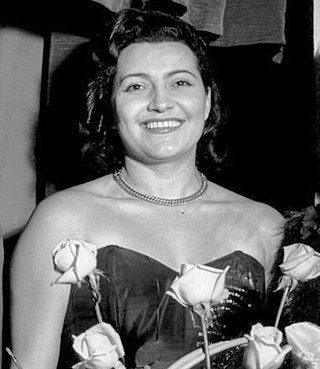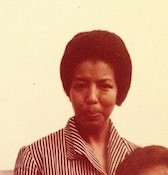
Gabriella Ghermandi (born 1965) is an Italo-Ethiopian writer and performer. [1] Ghermandi's writing focuses on the intersection of African (specifically Ethiopian) and Italian identity. [2]

Gabriella Ghermandi (born 1965) is an Italo-Ethiopian writer and performer. [1] Ghermandi's writing focuses on the intersection of African (specifically Ethiopian) and Italian identity. [2]
Ghermandi was born in Addis Ababa to an Italian father from Bologna and an Italo-Ethiopian mother. Ghermandi's mother was born to an Italian military officer and Eritrean mother who were separated due to racial policies of the then Fascist-controlled colony Italian East Africa before marrying Ghermandi's Italian father following the end of the Fascist Italian government. [1] Ghermandi states that she was brought up "white" by her mother, stating that her mom had faced exclusion from the Ethiopian community when she was being raised in an Italian convent due to her mixed-race status. [3] Following the death of her father, Ghermandi moved to Bologna at the age of 14. In her adolescence in Bologna, Ghermandi has stated feeling homesick and having a longing for her community in Ethiopia. [1]

Ghermandi gained recognition in 1999, winning the Elks&Tra Literary Prize for migrant writers through the publisher Fara Editore. She went on to win third place two more times in 2001 and 2003 in the same competition. [4] In 2003, Ghermandi was one of the founders of the online literary journal El Ghibli. [5] Ghermandi's first novel, Regina di fiori e di perle (Queen of Flowers and Pearls) was published by Donzelli Editore in 2007. [6] An English language translation was published in 2015 and earned positive reviews. [7] [8]
In 2010, Ghermandi started the Atse Tewodros Project, a music project named for Atse Tewodros II, the first Ethiopian emperor not of royal descent. The project's first CD was originally self-released in 2013 and then was released by the label ARC Music in 2016, titled Ethiopia - Celebrating Emperor Tewodros II. [9] Since 2018, Ghermandi has been working on another project titled Maqeda, named for the Ethiopian name of the Queen of Sheba, focusing on femininity in Ethiopian mythology. [10]

Margherita of Savoy was Queen of Italy by marriage to her first cousin King Umberto I of Italy. She was the daughter of Prince Ferdinand of Savoy, Duke of Genoa and Princess Elisabeth of Saxony, and the mother of the King Victor Emmanuel III of Italy.

Menelik II, baptised as Sahle Maryam was king of Shewa from 1866 to 1889 and Emperor of Ethiopia from 1889 to his death in 1913. At the height of his internal power and external prestige, the process of territorial expansion and creation of the modern empire-state was completed by 1898.

The emperor of Ethiopia, also known as the Atse, was the hereditary ruler of the Ethiopian Empire, from at least the 13th century until the abolition of the monarchy in 1975. The emperor was the head of state and head of government, with ultimate executive, judicial and legislative power in that country. A National Geographic article from 1965 called imperial Ethiopia "nominally a constitutional monarchy; in fact [it was] a benevolent autocracy".

Tewodros II was Emperor of Ethiopia from 1855 until his death in 1868. His rule is often placed as the beginning of modern Ethiopia and brought an end to the decentralized Zemene Mesafint.

Gondar, also spelled Gonder, is a city and woreda in Ethiopia. Located in the North Gondar Zone of the Amhara Region, Gondar is north of Lake Tana on the Lesser Angereb River and southwest of the Simien Mountains. As of 2023, Gondar has an estimated population of 487,224.

Adionilla Pizzi, known by her stage name Nilla Pizzi, was an Italian singer and actress.

Iyasu II , throne name Alem Sagad, was Emperor of Ethiopia from 1730 to 1755, and a member of the Solomonic dynasty. He was the son of Emperor Bakaffa and Empress Mentewab.

Tekle Giyorgis II was Emperor of Ethiopia from 1868 to 1871. After being crowned, he linked himself to the last independent emperors of the Gondar line through his mother and sought support from the Ethiopian Church to strengthen his right to rule. He was wounded when fighting during the 1871 Battle of Adwa, leading to the demoralization of his troops and capture of him and his generals and later on his death in captivity.

Franco Fontana is an Italian photographer. He is best known for his abstract colour landscapes.
Sahle Dengel was Emperor of Ethiopia intermittently between 1832 and 11 February 1855, towards the end of the Zemene Mesafint. He was largely a figurehead, with real power in the hands of Ras Ali II of Yejju.
Tiruwork Wube, also known as Queen Terunesh, was Empress consort of Ethiopia as the second spouse of Emperor Tewodros II of Ethiopia.
Articles related to Ethiopia include:

The Army of the Ethiopian Empire was the principal land warfare force of the Ethiopian Empire and had naval and air force branches in the 20th century. The organization existed in multiple forms throughout the history of the Ethiopian Empire from its foundation in 1270 by Emperor Yekuno Amlak, to the overthrow of the monarchy and Emperor Haile Selassie in 1974 by members of the Ethiopian army. Due to the country's position along multiple trade routes and its maintenance of independence against multiple Islamic and colonialist invasions lead to multiple conflicts against numerous major countries including the Ottomans, Egyptians, British, and Italians.

Ethiopia is one of the oldest countries in Africa; the emergence of Ethiopian civilization dates back thousands of years. Abyssinia or rather "Ze Etiyopia" was ruled by the Semitic Abyssinians (Habesha) composed mainly of the Amhara, Tigrayans and the Cushitic Agaw. In the Eastern escarpment of the Ethiopian highlands and more so the lowlands were the home of the Harari/Harla that founded Sultanates such as Ifat and Adal and the Afars. In the central and south were found the ancient Sidama and Semitic Gurage, among others.

Italians of Ethiopia are Ethiopian-born citizens who are fully or partially of Italian descent, whose ancestors were Italians who emigrated to Ethiopia starting in the 19th century during the Italian diaspora, or Italian-born people in Ethiopia.

Giuliana Luigia Evelina Mameli, was an Italian botanist, and naturalist.

Senedu Gebru was an Ethiopian educator, writer and politician. In 1957, she became the first Ethiopian woman elected to Parliament.

Agitu Ideo Gudeta was an Ethiopian Oromo farmer, entrepreneur, and environmentalist who immigrated to Italy after experiencing conflict due to her political activism against land grabbing by the military for international corporations. She established a goat farming operation using the indigenous breed Pezzata Mòchena to produce dairy and beauty products. Gudeta became a national symbol of environmentalism and successful refugee integration into Italian society by the press and politicians. She was assassinated in December 2020; Adams Suleiman, a Ghanaian seasonal worker she had hired, was charged with raping and murdering her.

Eritreans in Italy are residents of Italy who were born in Eritrea or are of Eritrean descent. According to the United Nations, there were 13,592 Eritrean migrants in Italy in 2015.

Oreste Bonomi was an Italian Fascist politician, who served as the last Minister for Exchanges and Currencies of the Mussolini Cabinet from February to July 1943.